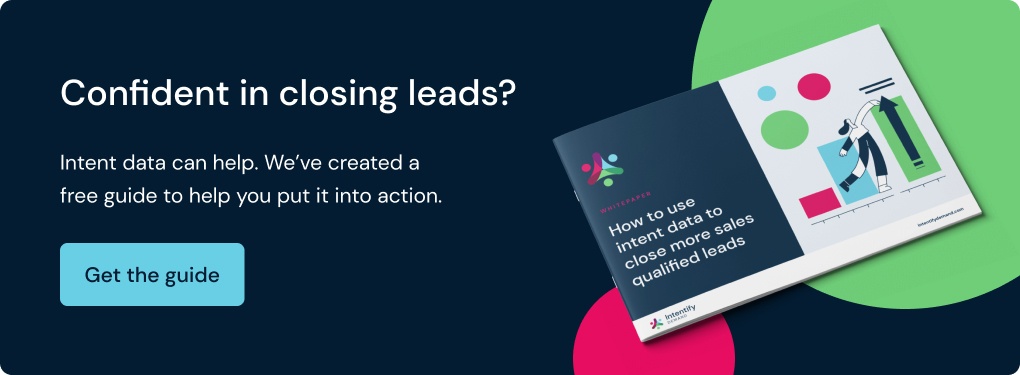Read time: 7 minutes
Unqualified leads are a problem. It's a simple fact, and it impacts both marketing and sales teams. According to research from Gartner, only 44% of leads are identified as being a good fit.
Intent data is a big help when solving this problem. Leveraging intent data correctly can indicate the likelihood of an individual buying your product or service. This means B2B marketers can identify good-fit leads, personalise their marketing strategies and drive conversions as a result.
Recommended reading: Purchase intent: How to find best-fit lead opportunities
And if you're looking to use intent data, you must first understand it. So, let's break down the most popular intent data terms you'll likely come across.
1. Account-based marketing (ABM)
Account-based marketing (ABM) focuses time and resources on targeted, individual prospects instead of the whole market. Intent data helps inform ABM strategies, giving teams insights on who is more likely to convert into a sales opportunity.
2. Account-based experience (ABX)
Account-based experience (ABX) is an evolution of ABM activity that focuses on how the end user interacts with your brand. This is where sales and marketing teams work together to ensure messaging aligns with where the customer is in the sales funnel.
3. Buyer intent data
Buyer intent data refers to online behaviour that indicates whether or not an individual intends to make a purchase. Ultimately, it's a collection of digital signals that show which topics that individual is interested in and can be compared against patterns of buying behaviour to predict how close they are to making a purchase.
4. Buyer persona
A buyer persona is a fictionalised representation of who your customers are. You can have several buyer personas, each one focusing on different challenges, pain points, or decision-making power. They're an important part of marketing as they help to provide structure and context for various types of strategies, including brand awareness campaigns, engagement, retention and nurture.
5. Engagement data
Engagement data is captured when an individual engages with a brand's website, social media content or email campaigns. It includes a wide range of metrics, such as likes, shares, clicks and comments.
6. Firmographic data
Firmographic data describes different attributes of an organisation, such as:
- Company size/employee count
- Industry
- Revenue
- Location
- Customer base
7. First-party data
First-party intent data is collected through channels you own and where you have a direct relationship with the user. For example, through your website or your social media channels.
Recommended reading: Why we use 1st party data (and what that means for you)
8. High intent keywords
High intent keywords are often specific and demonstrate a higher intent to purchase. For example, branded keywords or product names would be considered high intent keywords as customers searching with a branded keyword are considered to be much closer to making a purchase.
9. Ideal customer profile (ICP)
An ideal customer profile (ICP) describes the perfect customer you want to target. This is often based on factors such as company size, revenue, industry, geography and sometimes even purchase history. An accurate and relevant ICP is crucial for informing marketing and techniques as well as helping sales teams know which accounts and contacts to nurture.
Recommended reading: How to build an ideal customer profile for better lead generation results [+ free template]
10. Intent data
B2B intent data refers to the likelihood that an individual is going to make a purchase. It's a compilation of online digital signals that predict what an individual is likely to do next. B2B intent data is able to provide a clear picture of where an individual is in the buying journey and therefore indicate what marketers should do next to convert them.
11. Intent data providers
Intent data providers have access to large pools of B2B intent data and are able to use this to accurately predict an individual's intent to purchase. They often have access to numerous intent data sources and in-house tech.
12. Intent keywords
B2B marketers can assign intent to a prospective buyer by monitoring the content they read and the relevant keywords within it. For example, if someone is engaging with content that uses the keyword ‘free', they're likely not ready to buy. But prospects looking for informative content with keywords such as ‘How to' are a good opportunity for lead nurturing. Then there are your high-intent keywords indicating a good chance for a sales conversion.
13. Intent-qualified account (IQA)
An intent-qualified account (IQA) is the entire organisation that, thanks to your B2B buyer intent data, is worth pursuing as a sales prospect. This is often due to multiple individuals within the organisation showing a keen interest in your product or service.
14. Intent-qualified lead (IQL)
An intent-qualified lead (IQL) is a contact who is actively searching for or demonstrating an interest in your product or service and is therefore worth pursuing.
15. Intent score
An intent score is a numeric value assigned to a prospect based on their intent signals and their likelihood of making a purchase. Intent scores can be used to help prioritise leads in a marketing strategy to ensure resources are being directed towards those most likely to convert.
16. Intent signals/event
Intent signals are singular events that tell of an individual's interest in specific topics. Mapping multiple signals gives a clearer picture of an individual's intent to purchase and where they may be in the marketing funnel.
Recommended reading: Intent signals: The difference between signals and high intent
17. Intent topics
While intent keywords are very specific to each piece of content consumed, intent topics are able to provide more context. This means product pages or downloadable resources are able to have more weight compared to a blog post that has the same keywords. For example, a prospect reading a blog shows some level of interest versus a prospect who downloads a case study with the same keywords. The individual interested in a case study is more likely to be closer to making a purchase.
18. Lead scoring
Lead scoring is a method used to determine how valuable a lead is to the business. While intent-based scoring focuses on whether or not a lead is likely to buy soon, interest-based lead scoring includes a number of different prospect actions, including email opens, website visits, and the number of resources downloaded. The model will assign a varying number of points for each action depending on its perceived value to the marketing and sales teams. For example; a website visit might score 5 points, whereas an asset download is perceived as a higher interest and so may score 15 points.
19. Low intent keywords
Low intent keywords are considered to be broader and while they signal an intent to purchase, they normally indicate a prospect is higher up the funnel. It may be that these individuals are simply still in the research phase and are not yet ready to make a decision.
20. Natural language processing (NLP)
Natural language processing (NLP) is a subset of computer science and linguistics that focuses on the interactions between computing and human language. It analyses large amounts of human language data to provide context to written and spoken words.
21. Purchase intent data
Purchase intent data is another term for buyer intent data and is often used interchangeably. It refers to the intent to purchase.
22. Search intent data
Search intent data (also known as user intent) is captured when an individual types a query into a search engine such as Google or Bing.
23. Technographic data
Technographic data refers to the tech being used by a business. This includes hardware, software and applications, and can also include purchase or renewal dates.
24. Third-party data
Third-party intent data is collected on third-party platforms and tracks a variety of different online activities. These types of intent signals can include everything from social media interactions to web searches.
25. Topic clusters
Topic clusters are groups of closely related keywords that can give a more accurate view of a specific topic. They aim to provide a multifaceted view of a product, service or topic that is all-encompassing and therefore likely to be more indicative of a trend. This is much more sophisticated than keyword-based intent that simply relies on what's on the web page.
26. Topic taxonomy
Topic taxonomy is a categorisation of topics to understand how they may be related. Grouped hierarchically, topic taxonomy allows complex AI and machine learning tools to understand the relationships between topic clusters.
Know your jargon
Understanding this growing list of intent terms will help you become more strategic in your execution of intent data. It's a powerful tool when used correctly, and the trick is knowing how to use it. 56% of marketers agree leveraging intent gives them an advantage over their competitors.
This article was updated 15th January, 2024



